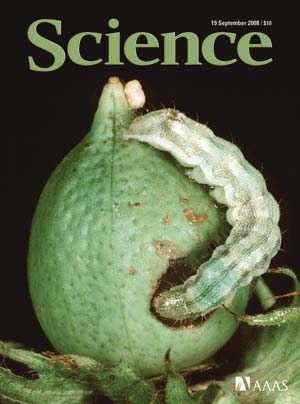Chinese research into GM cotton makes cover of 'Science'
BEIJING -- Newly released results from Chinese scientists' research into genetically modified (GM) cotton will be featured in a cover story in the latest issue of Science magazine on Friday.
Wu Kongming, a researcher from the Chinese Academy of Agricultural Sciences, said in the paper that bacillus thuringiensis (BT) cotton could defend itself against cotton boll worms as well as protect neighboring crops such as soybean and sorghum.
 The cover of the September 19 issue of Science magazine. [Courtesy of Science magazine] |
The cotton is the main host crop for the destructive insect, which often breeds in the plant, Wu said.
Wu and his team worked on the project from 1997 to 2007. Their study covered about 3,800 hectares of GM cotton in six provinces of Shandong, Hebei, Henan, Jiangsu, Anhui and Shaanxi.
The research found that after the cotton was planted, the population of boll worms decreased sharply. In addition, cotton yields increased by 15-20 percent and pesticide use could be cut by up to 50 percent. The team said these factors helped the ecology and rural people's health.
Bacillus thuringiensis is a soil microorganism with a pest-killing insecticide. In recent years, the gene inside BT that expresses the insecticide effect has been cloned in several plants, including corn and potatoes. BT has been used in pesticide since 1960 and is considered harmless to humans, animals, fish and most insects.
In rural areas, the biggest danger to the cotton crop is the boll worm, which at times has devastated harvests. For example, it caused about a 30 percent reduction in cotton output in 1992 in north China, at a cost of more than 10 billion yuan (about $1.5 billion).
Wu said, however, that "a major challenge to the success of BT cotton in China remains the potential for insects to develop resistance to it."
China has about 5-6 million hectares of land under cotton cultivation each year, of which about 70 percent is GM cotton. Last year, the use of GM cotton cut pesticide use by more than 140,000 tons.
Labels: Culture, skills, society, Technology

0 Comments:
Post a Comment
Subscribe to Post Comments [Atom]
<< Home